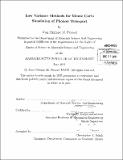Low variance methods for Monte Carlo simulation of phonon transport
Author(s)
Péraud, Jean-Philippe M. (Jean-Philippe Michel)
DownloadFull printable version (8.643Mb)
Other Contributors
Massachusetts Institute of Technology. Dept. of Materials Science and Engineering.
Advisor
Nicolas G. Hadjiconstantinou.
Terms of use
Metadata
Show full item recordAbstract
Computational studies in kinetic transport are of great use in micro and nanotechnologies. In this work, we focus on Monte Carlo methods for phonon transport, intended for studies in microscale heat transfer. After reviewing the theory of phonons, we use scientific literature to write a Monte Carlo code solving the Boltzmann Transport Equation for phonons. As a first improvement to the particle method presented, we choose to use the Boltzmann Equation in terms of energy as a more convenient and accurate formulation to develop such a code. Then, we use the concept of control variates in order to introduce the notion of deviational particles. Noticing that a thermalized system at equilibrium is inherently a solution of the Boltzmann Transport Equation, we take advantage of this deterministic piece of information: we only simulate the deviation from a nearby equilibrium, which removes a great part of the statistical uncertainty. Doing so, the standard deviation of the result that we obtain is proportional to the deviation from equilibrium. In other words, we are able to simulate signals of arbitrarily low amplitude with no additional computational cost. After exploring two other variants based on the idea of control variates, we validate our code on a few theoretical results derived from the Boltzmann equation. Finally, we present a few applications of the methods.
Description
Thesis (S.M.)--Massachusetts Institute of Technology, Dept. of Materials Science and Engineering, 2011. Cataloged from PDF version of thesis. Includes bibliographical references (p. 95-97).
Date issued
2011Department
Massachusetts Institute of Technology. Department of Materials Science and EngineeringPublisher
Massachusetts Institute of Technology
Keywords
Materials Science and Engineering.